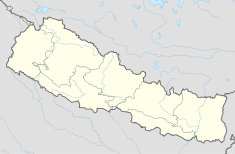|
Kathmandu Durbar Square
Kathmandu Durbar Square (Nepal Bhasa: येँ लायकु/𑐥𑐾𑑄 𑐮𑐵𑐫𑐎𑐹, Nepali: हनुमानढोका दरबार; Basantapur Durbar Kshetra) is a historically and culturally significant site in Kathmandu, Nepal. It is one of the three Durbar (royal palace) Squares in the Kathmandu Valley in Nepal that are UNESCO World Heritage Sites.[1] Although the construction of the square began in the 3rd century, the major structures within it were added in later periods. The outer complex consists of a number of 16th-century temples built during the reign of the Malla kings. These buildings are adorned with meticulously carved facades characteristic of Newar architecture. The central square is surrounded by palace complexes built during the Malla and Shah periods.[2] The most well-known among them is the Nautalle Durbar, a nine-story palace built by Prithvi Narayan Shah to commemorate the Unification of Nepal.[3] A three-story temple called Kumari Chouk or Kumari Bahal is located at the southern edge of the Durbar square. This Malla-era temple is used by the resident of the Kumari, a young girl worshiped as a living embodiment of the Hindu Goddess Durga.[2] Earthquake damageOn 25 April 2015, an earthquake with an estimated magnitude of 7.9 (Mw) hit the region and severely damaged the Square, reducing several buildings to rubble, the most prominent of which was the centuries-old wooden structure, Kasthamandap.[4][5] See alsoReferences
Further reading
External links
|
||||||||||||||||||||||||||||||||||||||||||


